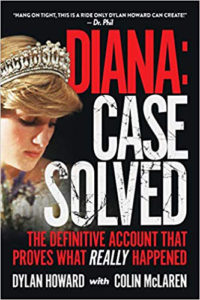By Edna Snidebottom,
I really looked forward to reading this book on Princess Diana by Dylan Howard with Colin McLaren. So many of us fell in love with this approachable Royal who seemed so kind and vulnerable and were stunned when she died so young. Just as with the death of President John Kennedy, conspiracy theories abound and this book takes pains to debunk most of them.

McLaren, a detective for many years, holds off on the renovation of his home as he watches news accounts of Diana’s death. The French police were treating it as a car accident instead of a crime scene. Fearing that if it was more than an accident, any possible evidence would soon be gone, he heads off to France to investigate.
I felt Colin McLaren’s observations to be very well documented and thorough. He makes diagrams and takes pictures of skid marks and the approach to the tunnel where Diana was killed. McLaren also conducts interviews of those living near the tunnel who might have heard or seen anything. He even checks out the bars and restaurants that Henri Paul, the chauffeur of the Mercedes-Benz, stopped at on that fateful night. He concludes that Paul definitely should not have been driving with the amount of alcohol he had consumed. There were also reports that he was on drugs for depression.
McLaren concludes that the Mercedes-Benz traveling at a very high rate of speed merged into the tunnel at the same time as a Fiat driving at a normal rate of speed. The impact with the Fiat sends the Mercedes into the wall of the tunnel and then careening into the third piller inside the tunnel. From the pictures of the Mercedes it is hard to believe that anyone survived but Diana’s bodyguard Trevor Rees-Jones did. To this day, he has no memory of what happened that night. McLaren and Howard even track down the man who was driving the Fiat, Le Van Thanh. If he was part of some plot it seems unlikely he would still live in the same area.
By the end of chapter ten, you have the feeling that McLaren has concluded that this was an accident but is saddened by the lack of investigation or interest by the French authorities.
Chapters eleven through fifteen are focused on all the reasons people still believe Diana might have been killed. It does seem an odd coincidence that Diana said in a letter written in 1996, “My husband is planning ‘an accident’ in my car.” They also discuss a box Diane called her “Crown Jewels” which contained tape recordings, threatening letters from Prince Phillip, and photos of Charles in compromising situations with men.
The mystery I would liked solved is why Diana’s sister Sarah, who was executor of her estate would have let Paul Burrell (Diana’s butler) take possession of the ‘Crown Jewels’ for safekeeping after having seen as she describes ‘sensitive material.’ And of course the box now seems to have disappeared.
In the final chapter (16), Howard launches into a ‘what if Diana had lived fantasy’ describing how she would have had a scar on her face from the accident and would not have been able to wear gowns showing cleavage. Also he knows the advice she would have offered to her daughter-in-laws Kate and Meghan and even the fact that she would have used botox to stay young-looking. And just to make this even more ridiculous, he knows she would have adored Barrack Obama and of course hated Donald Trump. Are we surprised, with his connection to Hollywood? It’s a shame the authors didn’t eliminate this chapter altogether. That being said, this is still a very interesting read.
Diana: Case Solved is available at www.amazon.com.